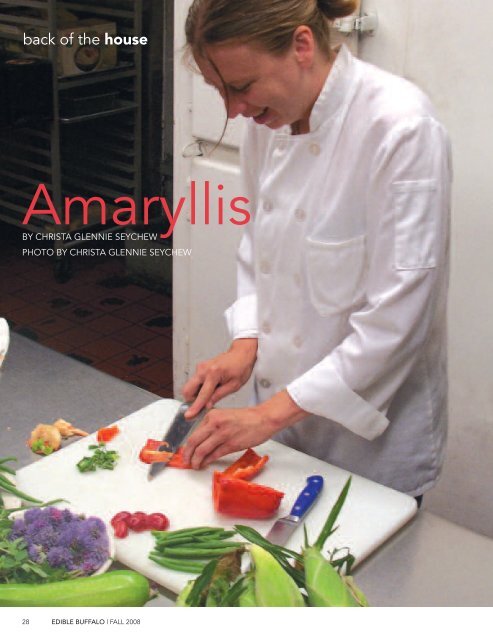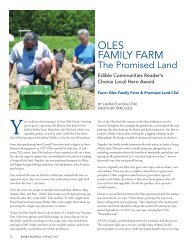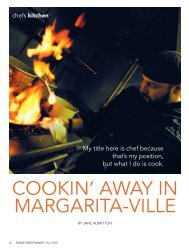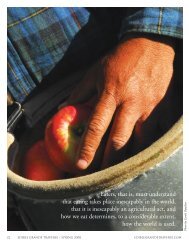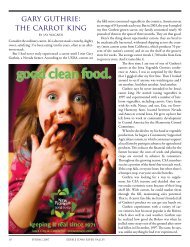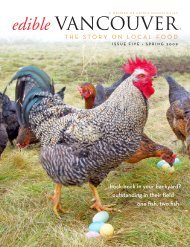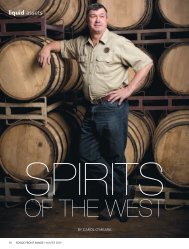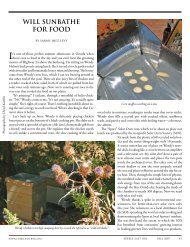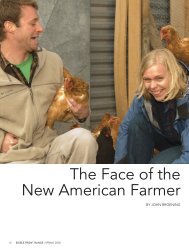back of the house - Edible Communities
back of the house - Edible Communities
back of the house - Edible Communities
You also want an ePaper? Increase the reach of your titles
YUMPU automatically turns print PDFs into web optimized ePapers that Google loves.
ack <strong>of</strong> <strong>the</strong> <strong>house</strong><br />
Amaryllis<br />
BY CHRISTA GLENNIE SEYCHEW<br />
PHOTO BY CHRISTA GLENNIE SEYCHEW<br />
28 EDIBLE BUFFALO | FALL 2008
“I have vegetarians coming tonight,” she says as we step <strong>of</strong>f <strong>the</strong> curb and<br />
cross Buffalo’s Main Street, home every Tuesday and Thursday during <strong>the</strong><br />
warm season to <strong>the</strong> Downtown Country Farmers Market. With cash in<br />
her pocket and a messenger bag slung over her shoulder, Chef Jennifer<br />
Stainrook, owner <strong>of</strong> Amaryllis, tells me that her regular vegetarian guests<br />
know to call ahead so that she can make a special effort for <strong>the</strong>m.<br />
“I like to check everything out first,” she tells me, perusing <strong>the</strong> day’s <strong>of</strong>ferings,<br />
“and <strong>the</strong>n go <strong>back</strong> and pick up what I need.” She selects parsley<br />
and brussles sprouts, some fresh fruit for <strong>the</strong> evening’s galette. “A couple<br />
<strong>of</strong> years ago, people seemed very suspicious about what I was trying to<br />
do with my menu, but it’s so much more common today.”<br />
Stainrook is referring to <strong>the</strong> fact that Amaryllis’ menu changes dramatically<br />
with <strong>the</strong> season—as is <strong>the</strong> tradition with many fine restaurants—<br />
but subtle adjustments are made <strong>of</strong>ten enough that <strong>the</strong> restaurant has<br />
found it easiest to simply print <strong>the</strong> menus <strong>the</strong>mselves. The everevolving<br />
<strong>of</strong>ferings can be attributed to <strong>the</strong> fact that Stainrook shops for<br />
<strong>the</strong> restaurant’s food supply every day herself, something that European<br />
chefs think nothing <strong>of</strong> doing but which is a rare occurrence among most<br />
American chefs. Every day she heads out into <strong>the</strong> city to procure <strong>the</strong><br />
freshest local fruits and vegetables she can find. Sometimes she hits <strong>the</strong><br />
farmers market; o<strong>the</strong>r times its Guercio’s (Buffalo’s West Side import<br />
grocery store). In some cases, she’ll even stop at Wegmans, where she<br />
ferrets out <strong>the</strong> produce specifically identified as locally grown.<br />
And it isn’t just <strong>the</strong> produce, though <strong>the</strong> menu’s accent on fresh and delicious<br />
preparations is full <strong>of</strong> it. Stainrook also sources her proteins locally,<br />
but that’s not always an easy task. She’s found a number <strong>of</strong> local<br />
resources, but if she can’t find local, her next step is to find what’s<br />
freshest. It’s taken her almost a year to work her way through <strong>the</strong> entire<br />
cow purchased last year. She also sites local sources for lamb and pork.<br />
Amaryllis is located in <strong>the</strong> lower portion <strong>of</strong> <strong>the</strong> Westbrook Apartments,<br />
a tall building where Summer and Delaware Avenues meet. The space is<br />
<strong>of</strong> good size and well-appointed. Though Amaryllis has a captive audience<br />
<strong>of</strong> apartment dwellers, many <strong>of</strong> whom would be happy if she<br />
served chicken wings and pizza, Stainrook chooses to <strong>of</strong>fer healthier<br />
preparations; nothing on her menu is fried or laden with processed<br />
cheese. Though her sauces have roots in traditional French cookery,<br />
she’s worked to make <strong>the</strong>m lighter, more progressive. Some <strong>of</strong> <strong>the</strong>se<br />
preparations can be complicated and her flavors pairings complex, but<br />
more <strong>of</strong>ten than not <strong>the</strong> food is a simple, straight-forward approach to<br />
contemporary cuisine with an accent on freshness.<br />
Stainrook and staff have been in this space just under three years.<br />
Stainrook’s formal training goes <strong>back</strong> to San Francisco, where her time<br />
at <strong>the</strong> California Culinary Institute greatly influenced <strong>the</strong> way she<br />
thinks about food. Her instructors took <strong>the</strong>ir students on expeditions<br />
to local markets and farms and impressed upon <strong>the</strong>m <strong>the</strong> importance<br />
<strong>of</strong> cooking seasonally. From <strong>the</strong>re, Stainrook went to <strong>the</strong> Las Vegas<br />
kitchen <strong>of</strong> a French chef, a place where those concepts <strong>of</strong> freshness and<br />
seasonality were driven home. “If I had just come <strong>back</strong> to Buffalo<br />
after school, I may have forgotten all <strong>of</strong> those things and started<br />
cooking like everyone else. I think that being in a kitchen where those<br />
principles were practiced every day really made a difference for me.”<br />
Stainrook <strong>the</strong>n returned to Buffalo where she cooked in many <strong>of</strong> <strong>the</strong><br />
city’s kitchens before opening Amaryllis. “One <strong>of</strong> <strong>the</strong> o<strong>the</strong>r things I took<br />
away from my experience in Las Vegas was <strong>the</strong> family meal that was<br />
served to <strong>the</strong> staff every night. After working in restaurants in Western<br />
New York for a few years I saw that <strong>the</strong> employees were really disconnected<br />
and, well, hungry.” By <strong>of</strong>fering her front and <strong>back</strong> <strong>of</strong> <strong>the</strong> <strong>house</strong><br />
staff a good meal every night, she not only ensures that everyone is fed,<br />
but that <strong>the</strong> team functions more like a family. “This is a business,” she<br />
said, “and we are here to make money, but it’s more than that.<br />
“It’s about building community,” says Stainrook. “Going to <strong>the</strong><br />
market and buying directly from <strong>the</strong> farmers, it gives you a sense <strong>of</strong><br />
community. It’s about more than <strong>the</strong> food, though <strong>the</strong> food is important.<br />
When I go to Guercio’s, I get to know <strong>the</strong>m; <strong>the</strong>y know what<br />
I want, what I’m looking for. My orders from <strong>the</strong>m are always perfect.<br />
Buying locally gives me a better product, a healthier product. It also<br />
helps to build a better community. I want Buffalo to succeed and if<br />
everyone tried to buy local food, <strong>the</strong>y’d boost our economy.”<br />
As she plucks <strong>the</strong> delicate buds, one by one, from a periwinkle chive<br />
blossom, Stainrook explains to me how she feels about cooking. “The<br />
labor <strong>of</strong> cooking is what I really love. Going to <strong>the</strong> market is fun, and<br />
<strong>the</strong>n putting it all toge<strong>the</strong>r. And <strong>the</strong>n <strong>the</strong>re’s <strong>the</strong> immediate pay <strong>of</strong>f<br />
you receive from a happy customer. It’s connected to <strong>the</strong> seasons,<br />
more connected to life, to nature. Eating is a necessity <strong>of</strong> life. In that<br />
way it’s more rewarding than o<strong>the</strong>r [occupations].”<br />
“For some people, cooking is just a job, not a love. They don’t know<br />
any different. It’s not <strong>the</strong>ir fault; <strong>the</strong>y’ve learned what <strong>the</strong>y know from<br />
someone else. Sure I could serve chicken wings, but that wouldn’t be<br />
satisfying to me—or to my staff.” Stainrook holds her staff in very<br />
high regard. “They are all passionate about food in <strong>the</strong>ir own rite.<br />
We all care about what we’re doing.”<br />
The buzzer in <strong>the</strong> expansive kitchen sounds, signaling someone’s arrival<br />
at <strong>the</strong> front door. I follow behind Stainrook, and <strong>the</strong>n linger in<br />
<strong>the</strong> foyer while she runs up <strong>the</strong> stairs to answer <strong>the</strong> door. She immediately<br />
pops <strong>back</strong> down, buoyantly carrying a tall, sweeping stalk <strong>of</strong><br />
fresh, fragrant mint. Behind her comes <strong>the</strong> head waiter, carrying his<br />
bicycle down <strong>the</strong> stairs. “He promised me he would bring some fresh<br />
mint in with him today”, Stainrook says, somewhat breathlessly with a<br />
big smile on her face. “It grows in his <strong>back</strong>yard.” eB<br />
Christa Glennie Seychew is a former food editor for a popular Buffalobased<br />
magazine. She is currently involved in a variety <strong>of</strong> projects that<br />
focus on supporting and nurturing Buffalo’s bounty in addition to operating<br />
Feed Your Soul, an event production company that creates<br />
once-in-a-lifetime experiences for those who are culinarily inclined.<br />
EDIBLE BUFFALO | FALL 2008 29


